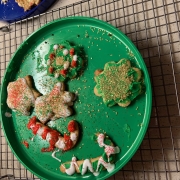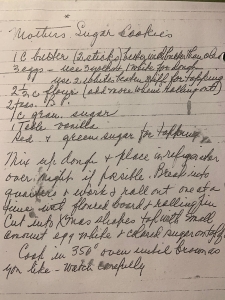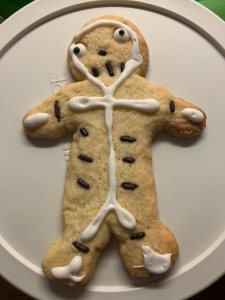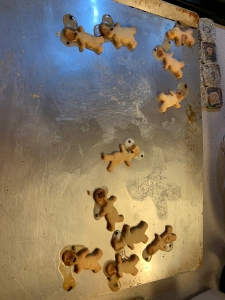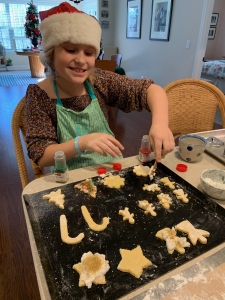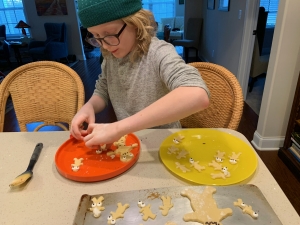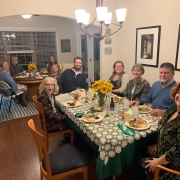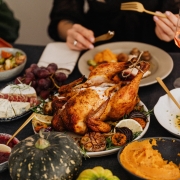Warm thanks to my friend, fellow Kentucky native and author Georgia Green Stamper, for sharing this grandmother’s tale of deja vu and antics that repeat across generations.
Last week, I tagged along with my youngest daughter, Georgeann, to Cincinnati. Her young children, Annelise and Hudson, made the jaunt from Lexington, Kentucky, with us. At five and almost three, they are now almost exactly the ages my two older daughters were when Georgeann was born. Strapped in the backseat in their state-of –the –art car carriers, with a movie playing on the DVD player and iPads loaded with games clutched in their hands, the children didn’t make a peep on the seventy-mile trip. Quite a contrast, I thought, to the long car trips of my young motherhood when I had only my imagination to keep the children entertained and separated in their minimally restrained seats.
But the moment we hit the six-lane traffic of I-75 – a stretch of city driving that puts me on edge – Annelise began to screech in a voice edged with panic. “Mr. Bear! Mr. Bear! Mr. Bear! Hudson is grabbing Mr. Bear!”
I turned around to investigate, and sure enough, there was Hudson with a big old grin on his face pulling as hard as he could on Mr. Bear’s head while Annelise held on to his body for dear life. Like a member of the family, Mr. Bear has been her near constant companion since she was an infant. Hudson is never allowed to touch Mr. Bear unless Annelise gives him permission for the occasional cuddle. (This is in no way a deprivation since their household has a few hundred stuffed animals tossed around. Okay, that’s an exaggeration but much of one.)
Déjà vu. Staring at my grandchildren pulling at opposite ends of Mr. Bear’s fragile body, I was transported back to 1977 on this same stretch of Interstate highway. Mother was with me then, sitting in the front passenger seat where I was now, and an infant Georgeann was cradled in her arms in those pre-safety seat days. I was at the wheel navigating unfamiliar urban traffic to pick up my husband at the Greater Cincinnati Airport.
My five-year-old daughter Shan was in the back seat with Bear, whom she never left at home. A plump half-pillow, half-plaything, he was handmade from a cloth cut-out, a craft notion popular in that era. The girls’ other grandmother had found Bear’s blue front and back body image at a fabric store, then stuffed him into a rotund pillow, and sewn up his exterior edges.
My mother-in-law had made a similar stuffed animal for our middle daughter Becky when she came along, but Becky could not be persuaded that her brown Dog was as fine as Shan’s blue Bear. And so, as I-75 widened from two lanes into many lanes, and the lightening fast traffic converged and diverged from all directions, Becky, a few months shy of her third birthday, grabbed Shan’s Bear by the head.
A frantic tug of war broke out, punctuated with shrieks and sobs. Mother, holding the baby in the front seat, could do little to intervene in the battle. I, of course, couldn’t cross multiple lanes of traffic to pull onto a shoulder if our lives had depended on it. My admonitions to “JUST STOP IT!” were ignored. (Where was Dr. Spock when you needed him?)
Tension was escalating in both the front and back seats of our car when suddenly the girls, in unison, let out a blood curdling scream. I nearly lunged into an eight-wheeler in an adjacent lane. What had happened? Had one of the back doors swung open despite being locked? Had someone fallen out of the car into the path of the trucks?
Bear’s decapitation is what had happened. His head was in Becky’s hands, his body in Shan’s, and his foam innards were flying all over the car like popcorn on steroids. Bear had lost his mind –and I was not far behind him.
Then, as both girls sobbed inconsolably in the back seat, Mother began to laugh and laugh until tears ran down her face. “You might as well,” she said.
Mother’s laughter restored both Bear and me to sanity. Within a few days, we had him re-stuffed and his head reattached with heavy thread. He soldiered on for many more years until his skin completely gave way to ravels and gaping holes. Then, we let him go to that special place in our hearts where we forever hold all of those we have loved.
Last week, my hand darted into the backseat in time to rescue Annelise’s Mr. Bear before his body gave way. But I heard my mother’s voice echo across the decades to remind both Georgeann and me to keep a sense of humor when dealing with the day-to-day challenges of parenting young children. You might as well laugh, she would say.
Certainly, it beats losing one’s head or one’s mind.

Copyright© Georgia Green Stamper
Excerpt from Butter in the Morning. Wind Publications. 2012.
(Available on Amazon.com)
Re-printed with Permission of the Author


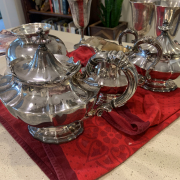

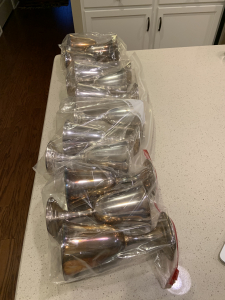
 My own treasured artifacts mostly weren’t made by our earlier generations, but I still enjoy thinking about what their spirits, if residing therein, could pass on to us. Could I replicate the hospitality at my own dinner parties that always illuminated my parents’ home by remembering to pull out my mother’s crystal wine glasses? If we keep that old rocker in the family circle, will we someday emulate with our younger members the long conversations I had with my dad when I sat in it, across from his favorite perch in their den, while we chatted?
My own treasured artifacts mostly weren’t made by our earlier generations, but I still enjoy thinking about what their spirits, if residing therein, could pass on to us. Could I replicate the hospitality at my own dinner parties that always illuminated my parents’ home by remembering to pull out my mother’s crystal wine glasses? If we keep that old rocker in the family circle, will we someday emulate with our younger members the long conversations I had with my dad when I sat in it, across from his favorite perch in their den, while we chatted?



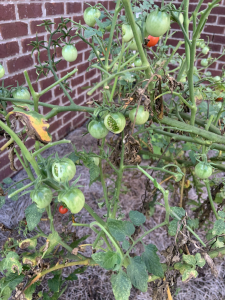



 Enough about ways we make it harder. What about ethics? (Gasp! Must we apply moral standards to Wordle? Examine your own conscience, is my advice.)
Enough about ways we make it harder. What about ethics? (Gasp! Must we apply moral standards to Wordle? Examine your own conscience, is my advice.)
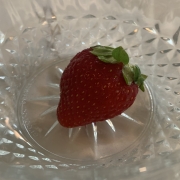
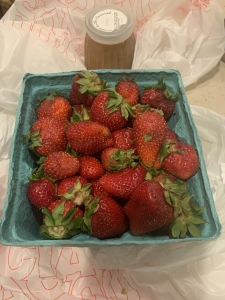 Admire them as you may, but there is a great secret among the most indefatigable of the Strawberry Tribe. We never make it through those recipes. Because we are bound to the only recipe that matters: Pop in mouth immediately. Follow with another. Continue with as many as possible, before the Blessed Season ends, all too soon.
Admire them as you may, but there is a great secret among the most indefatigable of the Strawberry Tribe. We never make it through those recipes. Because we are bound to the only recipe that matters: Pop in mouth immediately. Follow with another. Continue with as many as possible, before the Blessed Season ends, all too soon.
